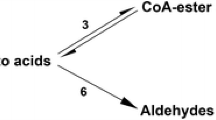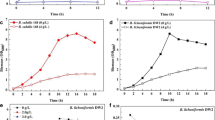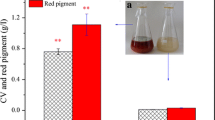Abstract
A spore-forming Bacillus sp. was isolated from a high-temperature Daqu, a starter culture of Chinese Maotai-flavor liquor, using an endogenous precursor screening strategy. The Bacillus sp. was capable of producing a high level of 2,3,5,6-tetramethylpyrazine (TTMP) via a precursor of 3-hydroxy-2-butanone (HB). The strain was characterized as Bacillus subtilis based on morphological, physiological, and biochemical properties as well as on partial 16S rRNA gene sequences. Different carbon and nitrogen sources as well as fermentation conditions were investigated. Optimization tests showed that oxygen supply and fermentation temperature were the most important parameters determining the production process. The production of >4.08 g/l TTMP was achieved together with a high level of endogenous precursor HB accumulation (>20 g/l) in both flask and fermentor cultures when the optimized medium and cultivation conditions were applied. Our data demonstrates the effectiveness of the endogenous precursor strategy for screening microorganisms that produce flavor compounds with structure-related precursors. The high yield of TTMP and the inexpensiveness of the agro-industrial product used as the substrate (soybean meal) indicate the potential of this process for industrial application.



Similar content being viewed by others
References
Adachi T, Kamiya H, Kosuge T (1964) Studies on the metabolic products of Bacillus subtilis. IV. determination and mechanism of formation of tetramethylpyrazine. Yakugaku Zasshi 84:545–548
Amranihemaimi M, Cerny C, Fay LB (1995) Mechanisms of formation of alkylpyrazines in the Maillard reaction. J Agric Food Chem 43:2818–2822
Besson I, Creuly C, Gros JB, Larroche C (1997) Pyrazine production by Bacillus subtilis in solid-state fermentation on soybeans. Appl Microbiol Biotechnol 47:489–495
Chen X, Chen S, Sun M, Yu Z (2005) Medium optimization by response surface methodology for poly-γ-glutamic acid production using dairy manure as the basis of a solid substrate. Appl Microbiol Biotechnol 69:390–396
Demain AL, Jackson M, Trenner NR (1967) Thiamine-dependent accumulation of tetramethylpyrazine accompanying a mutation in isoleucine-valine pathway. J Bacteriol 94:323–326
Fan WL, Xu Y, Zhang YH (2007) Characterization of pyrazines in some Chinese liquors and their approximate concentrations. J Agric Food Chem 55:9956–9962
Grundy FJ, Turinsky AJ, Henkin TM (1994) Catabolite regulation of Bacillus subtilis acetate and acetoin utilization genes by CcpA. J Bacteriol 176:4527–4533
Ho JW, Jie M (2007) Pharmacological activity of cardiovascular agents from herbal medicine. Cardiovasc Hematol Agents Med Chem 5:273–277
Huang M, Oppermann-Sanio FB, Steinbuchel A (1999) Biochemical and molecular characterization of the Bacillus subtilis acetoin catabolic pathway. J Bacteriol 181:3837–3841
Huang TC, Fu HY, Ho CT (1996) Mechanistic studies of tetramethylpyrazine formation under weak acidic conditions and high hydrostatic pressure. J Agric Food Chem 44:240–246
Jalbout AF, Shipar MAH (2007) Formation of pyrazines in hydroxyacetaldehyde and glycine nonenzymatic browning Maillard reaction: a computational study. Food Chem 103:1208–1216
Johansen L, Bryn K, Stormer FC (1975) Physiological and biochemical role of the butanediol pathway in Aerobacter (Enterobacter) aerogenes. J Bacteriol 123:1124–1130
Kim KS, Lee HJ, Shon DH, Chung DK (1994) Optimum conditions for the production of tetramethylpyrazine flavor compound by aerobic fed-batch culture of Lactococcus lactis subsp. lactis biovar. diacetylactis FC1. J Microbiol Biotechnol 4:327–332
Kosuge T, Kamiya H, Adachi T (1962) Isolation of tetramethylpyrazine from culture of Bacillus natto, and biosynthetic pathways of tetramethylpyrazine. Nature 195:1103
Larroche C, Besson I, Gros JB (1999) High pyrazine production by Bacillus subtilis in solid substrate fermentation on ground soybeans. Process Biochem 34:667–674
Li HB, Chen F (2004) Preparative isolation and purification of chuanxiongzine from the medicinal plant Ligusticum chuanxiong by high-speed counter-current chromatography. J Chromatogr A 1047:249–253
Liu B, Dean JR, Price R (1999) Extraction of tetramethylpyrazine from Ligusticum chuanxiong Hort. using phytosol solvent and supercritical fluid. Zhongguo Yiyao Gongye Zazhi 30:196–198
Liu XH, Li J, Li QX, Ai YX, Zhang L (2008) Protective effects of ligustrazine on cisplatin-induced oxidative stress, apoptosis and nephrotoxicity in rats. Environ Toxicol Pharmacol 26:49–55
Masuda H, Mihara S (1988) Olfactive properties of alkylpyrazines and 3-substituted 2-alkylpyrazines. J Agric Food Chem 36:584–587
Meara RAQO (1931) A simple delicate and rapid method of detecting the formation of acetylmethylcarbinol by bacteria fermenting carbohydrate. J Pathol Bacteriol 34:401–406
Miller GL (1959) Use of dinitrosalicylic acid reagent for determination of reducing sugar. Anal Chem 31:426–428
Moes J, Griot M, Keller J, Heinzle E, Dunn IJ, Bourne JR (1985) A microbial culture with oxygen-sensitive product distribution as a potential tool for characterizing bioreactor oxygen-transport. Biotechnol Bioeng 27:482–489
Nakashimada Y, Kanai K, Nishio N (1998) Optimization of dilution rate, pH and oxygen supply on optical purity of 2, 3-butanediol produced by Paenibacillus polymyxa in chemostat culture. Biotechnol Lett 20:1133–1138
Owens JD, Allagheny N, Kipping G, Ames JM (1997) Formation of volatile compounds during Bacillus subtilis fermentation of soya beans. J Sci Food Agric 74:132–140
Rizzi GP (1988) Formation of pyrazines from acyloin precursors under mild conditions. J Agric Food Chem 36:349–352
Schrader J (2007) Microbial flavour production. In: Berger RG (ed) Flavours and fragrances: chemistry, bioprocessing and sustainability. Springer, Berlin, pp 507–574
Sikkema J, Debont JAM, Poolman B (1995) Mechanisms of membrane toxicity of hydrocarbons. Microbiol Rev 59:201–222
Xiao ZJ, Xie NZ, Liu PH, Hua DL, Xu P (2006) Tetramethylpyrazine production from glucose by a newly isolated Bacillus mutant. Appl Microbiol Biotechnol 73:512–518
Xiao ZJ, Xu P (2007) Acetoin metabolism in bacteria. Crit Rev Microbiol 33:127–140
Acknowledgments
Financial support from the Ministry of Science and Technology, P. R. China under National Key Technology R&D Program (2007 BAK36B02 and 2008 BAI63B06), the Ministry of Education, P. R. China under the Program for Changjiang Scholars and Innovative Research Team in University (PCSIRT) (No. IRT0532), the Program of Introducing Talents of Discipline to Universities (111 Project) (111-2-6), the Natural Science Foundation of China (NSFC) (No. 30470046, 20872050), and the State Key Laboratory of Food Science and Technology, Jiangnan University (No. SKLF-MB-200801) is gratefully acknowledged.
Author information
Authors and Affiliations
Corresponding author
Rights and permissions
About this article
Cite this article
Zhu, BF., Xu, Y. & Fan, WL. High-yield fermentative preparation of tetramethylpyrazine by Bacillus sp. using an endogenous precursor approach. J Ind Microbiol Biotechnol 37, 179–186 (2010). https://doi.org/10.1007/s10295-009-0661-5
Received:
Accepted:
Published:
Issue Date:
DOI: https://doi.org/10.1007/s10295-009-0661-5




